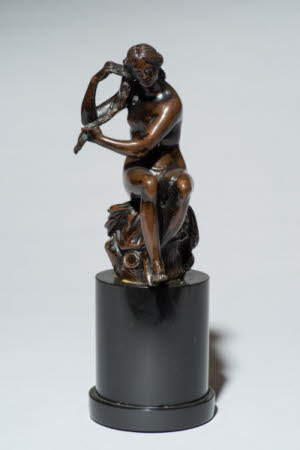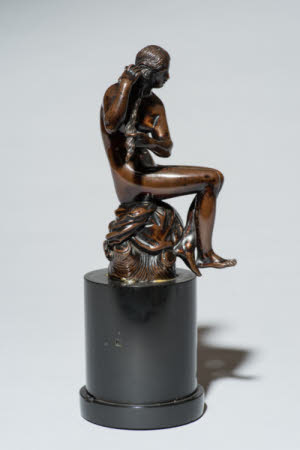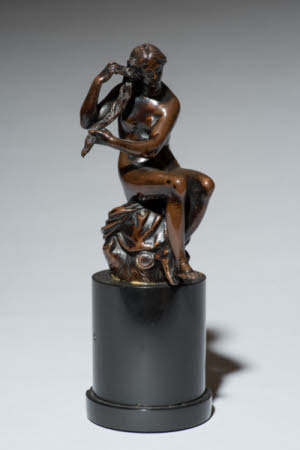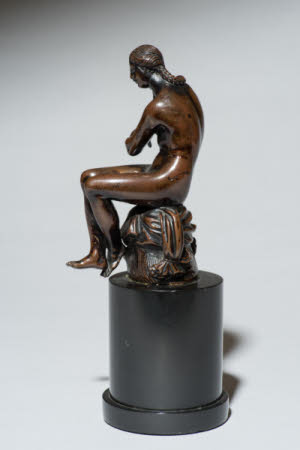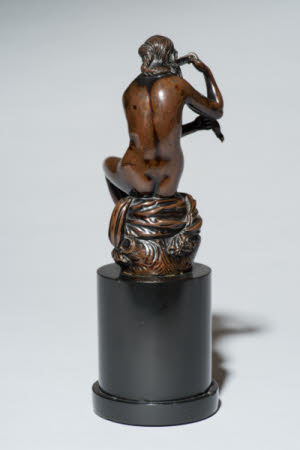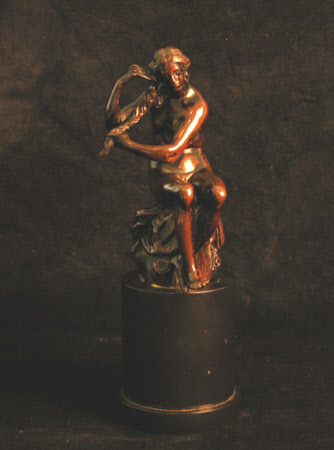Young woman combing her hair
attributed to Barthélemy Prieur (1536 - 1611)
Category
Art / Sculpture
Date
circa 1600
Materials
Bronze on marble
Measurements
224 mm (Height)
Place of origin
France
Order this imageCollection
Anglesey Abbey, Cambridgeshire
NT 515010
Summary
Bronze, Young woman combing her hair, attributed to Barthélemy Prieur (c. 1536-1611), c. 1600. A small bronze sculpture of a young woman combing her hair, made c. 1600 and attributed to the French sculptor Barthélemy Prieur (c. 1536-1611). The woman is naked, her legs slightly crossed, and she sits upon a piece of drapery spread over the top of a tree trunk. Her long hair is divided into two plaits, one of which is fully woven, whilst the other has been opened by the young woman, who holds it out with her left hand, whilst with the other she combs it carefully, using a two-sided comb.
Full description
The refined and beautifully modelled bronze figure is one of a group of female nude figures, all of around the same size, that show women engaged in various actions connected with the toilette. As well as combing the hair, they include a figure braiding her hair, another washing her foot and another cutting her toe-nails. All are seated in a similar manner, upon a tree-stump covered by a drapery, perhaps the woman’s shift. The four of these figures in the Huntington Art Collections, San Marino, California is the largest surviving group. It includes the young woman combing her hair (Inv. 17.18. R.R. Wark, Sculpture in the Huntington Collection, San Marino 1959, pp. 66-67, Plate XVI-XVIII). An example of the woman braiding her hair is in the Wallace Collection, London (Inv. S128), whilst a version of the woman cutting her toe-nails is in the Ashmolean Museum, Oxford (Inv. WA 1888.CDEF.B427). The little figures have long been associated with a further group of bronze figures showing other everyday activities, such as a couple going to market, or a maid milking a cow. One of the most remarkable is a composition in which an elegant naked young woman crouches down to help her young son as he urinates (for an example, see Robert Wenley, French Bronzes in the Wallace Collection, London 2002, pp. 30-31, Inv. S129). Because of their naturalism, the bronzes came to be regarded as Netherlandish works made under Italian influence, but in recent decades they have come to be accepted as the work of the talented French sculptor Barthélemy Prieur. As a young man Barthélemy Prieur spent several years studying and working in Rome, before moving to Turin in 1564, as court sculptor to the Duke of Savoy. By the early 1570s he was in Paris, where he made some outstanding large-scale bronze figures for monuments. However, in 1585, with the revocation of religious freedom as a result of the Edict of Nemours, Prieur, as a Protestant, had to flee to the Protestant enclave of Sedan in north-eastern France. It was whilst here that he seems to have begun to make his charming and intimate small-scale bronze sculptures, all of which are secular in their subject matter. After the accession to the French throne of the tolerant former Protestant Henri IV in 1589, Prieur was able in 1594 to return to Paris, where he worked as the king’s sculptor until Henri’s assassination in 1610, producing numerous portraits of the monarch and his consort Marie de’Medici. After his death in 1611, an inventory was made of the contents of Barthélemy Prieur’s house and workshop, in which were listed numerous figures of men and women, in the form of wax models and bronzes in various stages of completion. Although the subjects are not recorded, they are described as between five and eight pouces or inches high, i.e. c. 13-20 cm., thus more or less the height range of these small figures. A large number of the bronze models now associated with Prieur may be found in another post mortem inventory, that of King Louis XIV’s gardener André-le-Nôtre (1613-1700), who bequeathed his collections to his monarch. The list includes ‘two small bronze figures of seated women, one combing her hair, the other pulling a thorn from out of her foot’ (‘Item, deux autres petites figures de femme assises, l’une se peignant les cheveux, l’autre se tirant une épine du pied, de bronze, prisées 30 livres’; J. Guiffrey, ‘Testament et Inventaire après décès de André le Nostre et autres documents le concernant’, Bulletin de la Société de l’Histoire de l’Art Français, (1911), pp. 217–82, p. 254, no. 324). This is clearly the model of the Anglesey Abbey bronze. One of the group of bronzes, a girl cutting her toe nails, is specifically referred to in an inventory of goods belonging to the architect Jacques II Androuet du Cerceau drawn up in 1602, thus during the sculptor’s lifetime, as ‘a little figure in copper made by the hand of M. Barthelemy…’ (‘une petite figure de cuivre faicte de la main de Mr Barthelemy, laquelle figure es tune femme qui rogne les ongles de ses pieds’; Regina Seling-Teuwen, ‘Kavalier und Magd’, Weltkunst, 23 (1991), pp. 3706-09, p. 3708). This helps to confirm the attribution of this remarkable group of bronze figures to Barthélemy Prieur. A pair of small bronze leaping bulls at Anglesey Abbey are also attributable to Prieur (NT 515002-003). Jeremy Warren 2019
Provenance
Bequeathed to the National Trust by Huttleston Rogers Broughton, 1st Lord Fairhaven (1896-1966) with the house and the rest of the contents.
Credit line
Anglesey Abbey, The Fairhaven Collection (The National Trust)
Makers and roles
attributed to Barthélemy Prieur (1536 - 1611), sculptor
References
Christie, Manson & Woods 1971: The National Trust, Anglesey Abbey, Cambridge. Inventory: Furniture, Textiles, Porcelain, Bronzes, Sculpture and Garden Ornaments’, 1971, p. 138.
